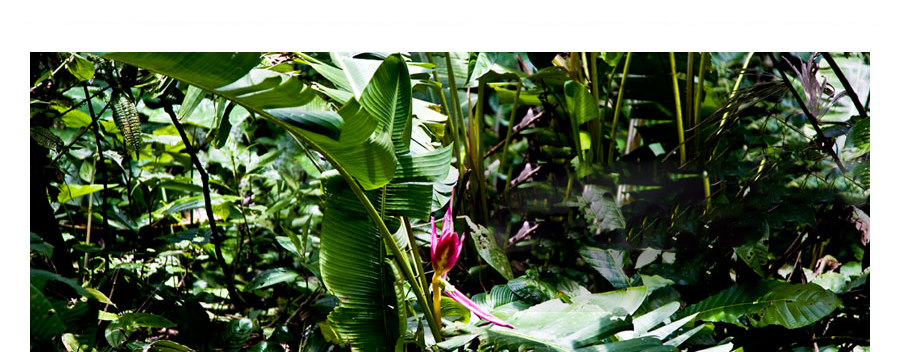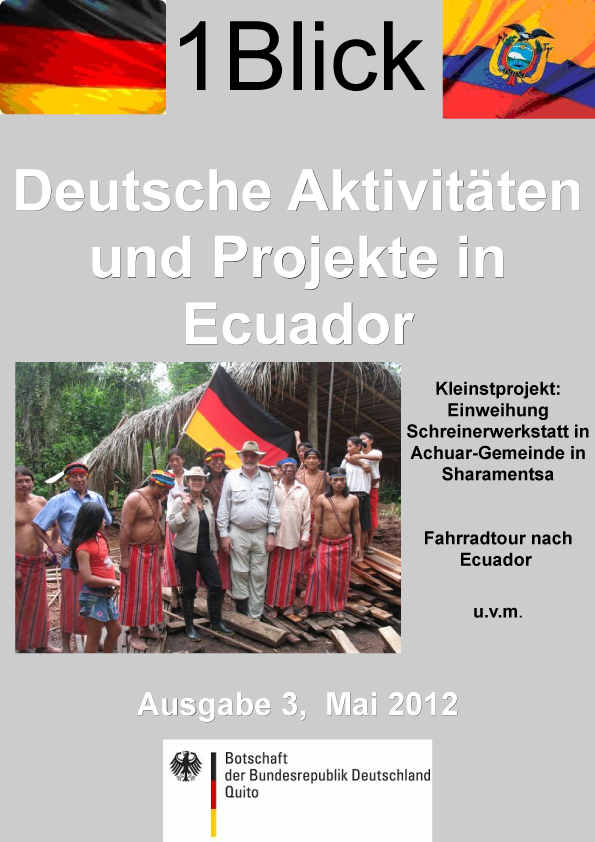THE GERMAN EMBASSY IN ECUADOR ACKNOWLEDGES THE IMPORTANCE OF OUR WORK
In its newsletter, the German Embassy in Quito, Ecuador’s capital city, highlighted the importance of the work that AMAZONICA and INDIO-HILFE has been doing for 30 years in support of Ecuador and its indigenous peoples. The article in German language is available on pages 5 – 9 of the newsletter in PDF.
The title photo shows the ribbon-cutting ceremony for the opening of the carpentry workshop in Sharamentsa. The event was attended by German Ambassador Peter Linder. The German Embassy financed the purchase of the power tools for the workshop.
30 year anniversary of the registered association INDIO-HILFE e.V., 1982 – 2012
30 years of successful work for Ecuador
It all began in 1980 with a holiday trip to Ecuador. On their tour, Ulrich Pohl and Mascha Kauka, a couple from Munich, visited the northern part of the province of Esmeraldas, the Río Cayapas and its tributaries. “At that time, Esmeraldas was really still emerald green,” Mascha Kauka recalls wistfully. “The jungle spread over the hills all the way down to the famous palm beach on the Pacific. We took a jeep and drove along the sandy trail along the coast until we reached La Tola. We then spent two days in a small outboard motor canoe traveling up river. Soon the map from the Instituto Geográfico Militar (Military Geographic Institute) came to an end in a big white spot – woodland which wasn’t measured at that time. That is where the Chachi people live.”
A chance encounter with a local tribal leader, Uñi Tapuyo, would become a fateful one. The Chachi people had never seen tourists before, but when they understood that the people from Munich had no bad intentions and weren’t searching for gold or for wood, Tapuyo and his sons confided in the couple: “You must help us. We are desperate. The state has leased our forest to logging companies. Our living space is in danger and they want to evacuate the area. You are white and understand the white world. You must advise us!”
As if it was that simple for two young entrepreneurs with a small publishing house on a shaky foundation, who spoke Spanish poorly and had no knowledge of South America, Ecuador and the rain forest not to mention indigenous people. “You have to measure our traditional settlement area, then it will belong to us. That is what the constitution says”, explained Uñi`s son, a teacher at the only elementary school.
The Pohl-Kauka couple didn’t promise anything, but they left their home address. It took only a few weeks for mail from the jungle to arrive. Six months later Mascha Kauka had convinced her husband to give it a try – “Let’s see what we can do”.
With regard to land measuring and issuing land titles for the local indigenous people, Ecuadorian law required that the territory be structured and that districts and villages be formed. “The approximately 7,000 Chachi were then nomadic within their river system areas,” explains Kauka. “Not only did we have to get the state department I.E.R.A.C. to measure the white spot on the map in the mountain forests, but we also had to launch a process for nomadic hunter-gatherers to become sedentary Ecuadorians, including all the education and infrastructure that this development requires – and of course we also had to pay for everything.”
In 1982, together with friends in Germany, the couple founded the nonprofit association INDIO-HILFE (“help for indigenous peoples”) to raise the necessary money and secure active support, and in 1983 they took on the huge task. When governments changed, the survey work was interrupted again and again, but the development work in the river area continued steadily. “This was learning by doing”, comments Kauka. “The years we spent with the Chachi were a kind of school. Since we had to tackle challenges in all areas of life, we learned to help with everything an indigenous group needs, especially in the rain forest.”
After 14 years, the Chachi were finally land owners. When the cooperation ended in 2001, by mutual agreement and in friendship, the region had a medical infrastructure (now operated by the Ministry of Health) with hospital and ambulance stations where Chachi people work as well as primary schools in 28 villages, training in agriculture and significant rice and sugar cane production for the first time, training in the trades and other occupations, and a brisk trade in arts and crafts.
Word spreads when a group does successful work with the government and the population (in the meantime the NGO had a cooperative agreement with the Ecuadorian government and also with the Ministry of Health). Due to a lack of money and time, INDIO-HILFE had to refuse many requests; after all, the members working on the projects in Ecuador did the work on a voluntary basis and also had jobs at home.
But in 1992 another big project came up, this time in the highlands province of Tungurahua at the foot of Mount Carihuairazo. “The Ministry of Health and a cooperative of Pilahuines asked me to take on the task. I was curious and wanted to broaden my horizons by learning a great deal about other peoples. At the same time, I wanted to take on the challenge of finding solutions that were still unknown. As soon as you know that you are able to help, you get almost addicted to expanding the possibilities”, says the publisher from Munich with a smile.
The problems facing the Pilahuines, Kichwa (Quichua) mountain farmers living at approximately 3,300 meters altitude, included the drinking water supply for three valleys and irrigating the arid lands on the steep slopes, organic farming, marketing products and medical care. “We found strong rural exodus and we wanted to bring the families back from the slums and create jobs for them in their mountains.” INDIO-HILFE built a partially roofed marketplace with a slaughterhouse on the road to Guaranda, so the farmers no longer had to travel far with their products. And that worked. Traders and merchants from as far away as Ambato and the lowlands came.
The organization purchased a 4-storey, dilapidated colonial house next to the San Roque market in Quito where, in the early 90′s, hundreds of Pilahuines were living in degrading conditions. The Pilahuines renovated it with the help of a professional construction manager. Now it is a hostel with almost 100 beds as well as storage, a nursery, a refectory and a telephone exchange for the mountain farmers and their clients on market days. The house has now belonged to them since 2004. INDIO-HILFE transferred the house called ‘Tambo Huasi’ to the co-ownership association of Kichwa people from 12 mountain villages.
Costa, Sierra – only the Amazonía was missing in the list of areas that had received help, but it didn`t take long to add the Amazon. After the conflict with Peru had ended, in 1996 a Sápara leader and the Ecuadorian Ministry of Health again applied for help from INDIO-HILFE. With a special permit for the military exclusion zone, the Pohl-Kauka couple traveled to the province of Pastaza up to the Río Tigre on the Peruvian border. Invitations from the Kichwa to the Río Curaray followed as well as from the Shuar and Achuar of Pastaza and Morona Santiago.
Their intellectual leaders had recognized that with the repeal of the exclusion zones and peace between Ecuador and Peru that peace in the forest was a thing of the past. They asked INDIO-HILFE for advice and support for their vision and their plan: “The pressure on our land is becoming more and more intense,” said Domingo Peas, an Achuar leader. “We must make our communities in the forest strong, educate the young people and create jobs, and encourage the families to try a new way of living with the forest. We indigenous peoples are the best guardians of our forest, but given the threats, we need allies. And we do not have much time. If we don’t manage this in one or two generations, we will be wiped out along with our forest.”
A contemporary way of living and working in the forest still had to be found and tested. This required a sophisticated model developed locally. The Kichwa of the Río Curaray, the Achuar of Pastaza and the Shuar of Transcutucú provided model communities for which INDIO-HILFE completed eight years of work in all areas.
This experience resulted in the AMAZONICA program and the establishment of the German foundation AMAZONICA for the “protection of tropical rainforests by assisting its indigenous peoples”. In addition, over three years the largest malaria campaign of the Amazon Basin was successfully carried out – a milestone! Because of the malaria epidemic in the years 2004/2005, INDIO-HILFE built the medical infrastructure from scratch for 112 villages with 12 ambulance stations. All 12,000 residents were given mosquito nets and there was a malaria worker as well as prevention training for each village. More than 30 indigenous paramedics were trained in the forest to become laboratory assistants for microscope work necessary for diagnosing and treating malaria. Five years after completing the campaign, the region is also largely free of malaria. In 2007, INDIO-HILFE transferred the infrastructure and personnel to the Ministry of Health.
The model created in collaboration with the local model communities was complete three years ago. Now there is an urgent need for its reproduction! About 200 villages asked to participate in the master plan. “It is purely a question of money, how fast we can help everywhere and in so doing, save large areas of the forest. The need and the expertise are there”, explains a worried Mascha Kauka. A widow since 2006, she manages all of the projects without the support of her first and most important comrade-in-arms.
And under her direction, the work has taken on a new dimension: “The young people in the world determine our life in the future. For this reason, we want to convey to them an understanding of the tropical rain forest and how to approach it responsibly.” This happens at the AMAZONICA Academy, a German nonprofit GmbH. This first jungle academy with offices in the Achuar and Shuar communities offers indigenous students and international universities an infrastructure for research and teaching in the primary forest as well as local jobs and income for the forest dwellers. Indigenous people and students from around the world cooperate on an equal basis.
In Ecuador, academy pioneers are the state University of Cuenca and the Polytechnic Institute of Quito. In Germany the Straubing Science Center, the Weihenstephan University of Applied Sciences, the University and Technical University of Munich and the Universities of Applied Sciences in Bielefeld and Ostwestfalen-Lippe. “We have always received encouragement and support from the German Embassy in Quito”, emphasizes Mascha Kauka. “Three ambassadors have already visited our projects, and recently the embassy financed the carpentry equipment with multiple machines for the model community of Sharamentsa. Officially this assistance is called “small-scale embassy projects”, but for the Achuar people and our common work, a professional carpenter’s workshop means great, ongoing help!”
- Interview by Samantha Weisflok -
AMAZONICA at




